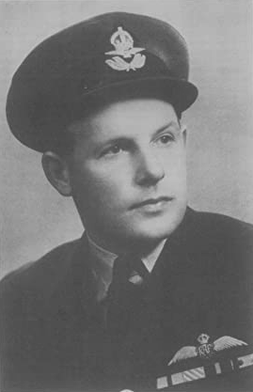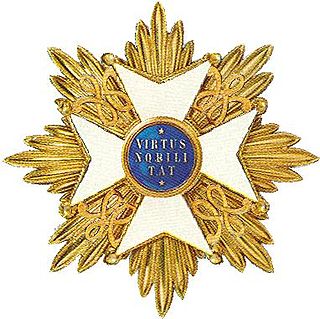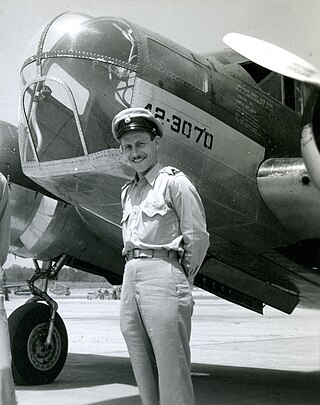The Commendation Medal is a mid-level United States military decoration presented for sustained acts of heroism or meritorious service. Each branch of the United States Armed Forces issues its own version of the Commendation Medal, with a fifth version existing for acts of joint military service performed under the Department of Defense.

The Distinguished Flying Cross (DFC) is the third-level military decoration awarded to officers, and since 1993 to other ranks, of the United Kingdom's Royal Air Force and other services, and formerly to officers of other Commonwealth countries, for "an act or acts of valour, courage or devotion to duty whilst flying in active operations against the enemy".

The Royal Netherlands Air Force is the military aviation branch of the Netherlands Armed Forces. It was created in 1953 to succeed its predecessor, the Luchtvaartafdeling of the Dutch Army, which was founded in 1913. The aerobatic display team of the Royal Netherlands Air Force, active from 1979 until 2019, was the Solo Display Team.

The Air Force Cross (AFC) is the United States Air Force and United States Space Force's second highest military decoration for airmen and guardians who distinguish themselves with extraordinary heroism in combat with an armed enemy force. The medal is awarded to any person, while serving in any capacity with the Air Force or Space Force, who distinguish themselves by heroism which is extraordinary but not sufficient for the award of a Medal of Honor.

The Military William Order, or often named Military Order of William, is the oldest and highest honour of the Kingdom of the Netherlands. It is named after St. William of Gellone (755–814), the first Prince of Orange. Its motto is Voor Moed, Beleid en Trouw. The chivalric order was established on 30 April 1815 by King William I and was presented for feats of excellent bravery on the battlefield and as a meritorious decoration to senior military officers. Comparable with the French Légion d’Honneur but far less often awarded, it is open to everyone regardless of rank or nobility—not only to Dutch military, but also to foreigners. To date, membership in the Order is extremely rarely awarded, and only for exceptional bravery in battle.

The Distinguished Flying Medal (DFM) was a military decoration awarded to personnel of the Royal Air Force and other British Armed Forces, and formerly to personnel of other Commonwealth countries, below commissioned rank, for "exceptional valour, courage or devotion to duty whilst flying in active operations against the enemy". The award was discontinued in 1993 when all ranks became eligible for the Distinguished Flying Cross (DFC) as part of the reform of the British honours system.
Authorized foreign decorations of the United States military are those military decorations which have been approved for wear by members of the United States armed forces but whose awarding authority is the government of a country other than the United States.
Awards and decorations of the United States Department of the Air Force are military decorations which are issued by the Department of the Air Force to airmen of the United States Air Force and guardians of the United States Space Force and members of other military branches serving under Air Force and Space Force commands.

Abraham Lamertus "Bram" van der Stok,, also known as Bob van der Stok, was a World War II fighter pilot and flying ace, and is the most decorated aviator in Dutch history.

In the Dutch honours system, most orders are the responsibility of ministers of the Netherlands Government. The house orders, however, are awarded at the discretion of the Dutch monarch alone.

Flight Lieutenant Henry Wallace McLeod DSO, DFC and Bar was a Canadian fighter pilot and flying ace with the Royal Canadian Air Force during the Second World War. He achieved a total of 21 enemy aircraft destroyed, three probably destroyed, and 11 damaged, and one shared damaged. McLeod scored 13 kills during the Battle of Malta, earning the nickname "The Eagle of Malta".
The Honorary Medal for Charitable Assistance was created at 18 June 1822 and is after the Military William Order the oldest decoration for bravery in the Kingdom of the Netherlands. Furthermore, the Honorary Medal is the highest civilian decoration still being awarded for bravery, and is specifically for those who carried out a voluntary act of bravery or self-sacrifice, with an emphasis on charity.

Donald Ernest Kingaby, was a Royal Air Force (RAF) aviator and flying ace of the Second World War. He was the only person to be awarded the Distinguished Flying Medal three times.
2e Afdeling, Vliegtuiggroep V or short 2-VLG-V was a squadron of the Royal Netherlands East Indies Army Air Force from the 1st of July 1941 to the 8th of March 1942.

Albert Eduard Stoové was a sergeant in the Royal Netherlands East Indies Army Air Force at the start of World War II. For several actions with the 2-VLG-V squadron under command of Captain Jacob Pieter van Helsdingen he received the Vliegerkruis on 24 February 1942.

Tadeusz Władysław Sawicz was a Polish World War II fighter pilot. He served in the Polish Air Force, and after the fall of Poland, he served in the Polish and allied units in France and United Kingdom. He was the commander of several air units, including the No. 315 Polish Fighter Squadron, 1st Polish Fighter Wing, 3rd Polish Fighter Wing, 131st (Polish) Fighter Wing and 133rd Fighter Wing. He participated in the Battle of Britain and was ranked as the 82nd highest scoring Polish fighter pilot of the war.

Lt. Colonel Jhr. Bodo Sandberg was a fighter pilot in the Royal Netherlands Air Force and 'Engelandvaarder' during World War II. He was awarded the Cross of Merit and the Airman's Cross for his bravery during the German invasion of May 1940.

The Air Force Cross, post-nominal letters CA, is a South African military decoration which was instituted by the Republic of South Africa in 1987. It was awarded to members of the South African Air Force for bravery. The decoration was discontinued in 2003, but backdated awards can still be made for acts of bravery during this period.

Henderikus "Pim" Sierks is a former airline pilot who most notably captained a Boeing 707 full of hostages and hostage takers during the 1974 French Embassy attack in The Hague.

Ida Laura Veldhuyzen van Zanten was a Dutch pilot and social worker who was a member of the Dutch resistance during the Second World War and a pilot in the British Air Transport Auxiliary. She was the only woman to receive the Vliegerkruis, the Airman's Cross.















